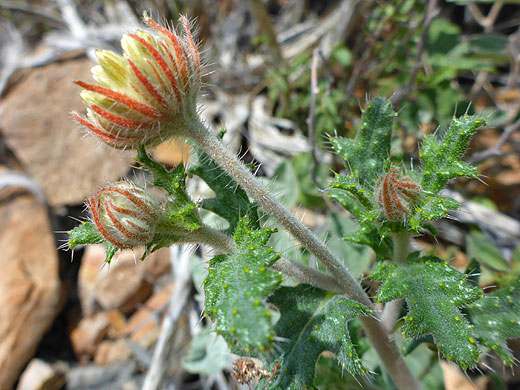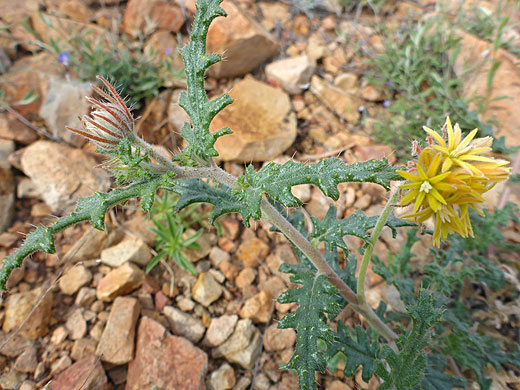Common name:
Stinging serpent
Family:
Scientific name:
Cevallia sinuata
Main flower color:
Range:
South Arizona, south New Mexico and west/north Texas
Height:
Up to 3 feet
Habitat:
Washes, rocky hillsides, roadsides; 2,200 to 5,200 feet
Leaves:
Elliptic, pinnately lobed, up to 3 inches long, on short stalks
Season:
March to October
Cevallia sinuata is an unusual species, the only one in its genus, characterized by thick, prickly, glandular leaves, and terminal clusters of yellow flowers subtended by linear, red-orange bracts. The hairs covering the leaves and stems are variable in length and thickness, and may be hooked, branched or stinging. Leaves are thick, lobed along the margins, and dotted with yellowish glands. Relatively long bristles line the edges, while the surfaces are covered with shorter hairs. Upper stem leaves are smaller, more lanceolate in shape, and stemless.
The inflorescence is a compact cluster on top of a thick, bristly, leafless stalk, up to 4 inches tall. Flowers have five linear, yellow sepals and five similar-looking petals; all are hairy, especially along the edges and undersurfaces. At the center are five stamens, with yellow filaments and white anthers, and a short style topped by a conical stigma. Flowers mostly bloom at night.
The inflorescence is a compact cluster on top of a thick, bristly, leafless stalk, up to 4 inches tall. Flowers have five linear, yellow sepals and five similar-looking petals; all are hairy, especially along the edges and undersurfaces. At the center are five stamens, with yellow filaments and white anthers, and a short style topped by a conical stigma. Flowers mostly bloom at night.
All Contents © Copyright The American Southwest | Comments and Questions | Contribute | Site Map





